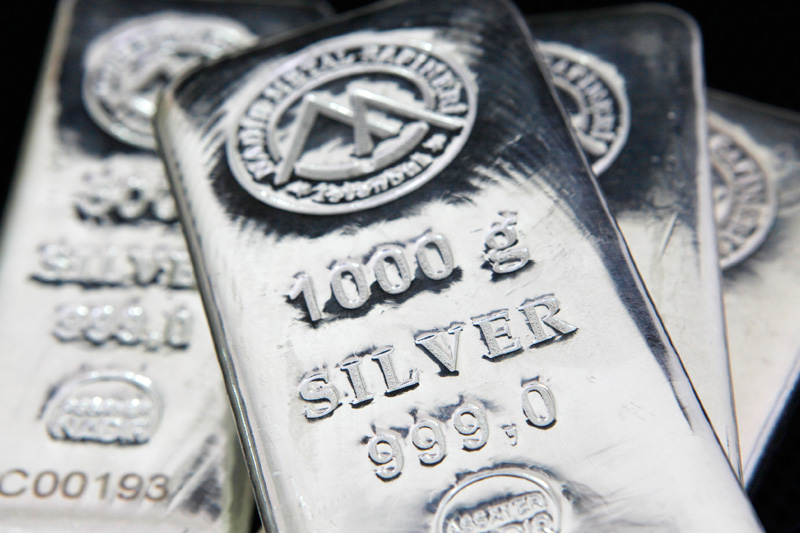By Peter Nurse and Geoffrey Smith
Investing.com -- Like its more illustrious relative gold, silver has been on a tear this week, climbing to a new seven-year high above $23 an ounce, only four months after hitting an 11-year low of under $12 in March. If 2020 hasn’t been volatile enough for you, then you might definitely want some silver in your portfolio.
But how sustainable is the rally in silver? Who wants it? Who needs it? And what assumptions does the rally rest on? Peter Nurse and Geoffrey Smith discuss. This is Point/Counterpoint.
The Bull Case
Silver is up 28% year to date, while gold has risen 23%. Investors should bet on more gains to come for the junior metal, which shares most of the fundamental factors supporting gold and has a couple of its own to boot.
To counter the economic effects of the coronavirus pandemic, governments and central banks have cut interest rates to the floor and injected trillions of dollars of liquidity.
With central banks around the world already wondering what more they can do (see the Fed’s flirtation with yield curve control or the Bank of England’s with negative interest rates), this state of play isn’t changing anytime soon.
Rock-bottom borrowing rates have reduced the opportunity cost of holding non-interest-bearing assets such as bullion. Hence, investment demand for bars and coins is soaring.
However, silver’s attractions go beyond being a mere store of value. It’s used in nearly every major industry, from electronics and medical applications to batteries and solar panels. Silver is the best conductor of electricity, making it very difficult to replace with other metals in many usages.
Take solar panels, for example, which account for about a fifth of silver’s industrial demand. A report by consultants CRU last month expected solar power to grow at a compound rate of nearly 10% for the next decade. Upside risks to that forecast abound, given the desire to “build back better” after the pandemic. Democratic Presidential candidate Joe Biden’s $2 trillion plan to green the energy and transport systems implies a lot more solar panel demand than his opponent’s policies. China, already the world’s biggest solar power market, is likely to increase installations this year, even given the difficult start to 2020.
Supply-side factors are also supportive, with output generally trending lower. Silver is usually by-product from mines that primarily dig out base metals or gold. At a time of tight exploration budgets, it’s hard to see the world’s miners bumping up exploration on the off-chance of finding some silver. In the meantime, Covid-19 continues to disrupt operations at some of the world’s biggest mines in Peru and Bolivia.
Finally, there’s historical precedent and mean-reversion. The ratio of gold to silver prices averaged 47:1 during the 20th century, and about 61:1 in the 21st century, according to data from goldsilver.com, yet sank to 30:1 at the peak of the bull market in 2011.
The current ratio stands well above 70:1, suggesting silver is historically undervalued compared with its more glamorous cousin.
“If the last major disruptive event of the past 15 years is any indication, a bullish environment for gold typically opens the door to bullish price action for silver. Market participants diversified some of their gold holdings to silver in previous scenarios, and such flows tended to cause outsized moves in the much smaller silver market,” said Jim Wiederhold, Associate Director of Commodities and Real Assets at S&P Dow Jones Indices.
The Bear Case
Silver is solid enough, but this rally is a straw fire that will burn itself out very quickly. For one thing, the perceived parallel with gold is spurious. Gold has the backing of the world’s central banks, which have bought thousands of tons of the stuff in recent years. The lack of a central bank bid renders any rally that relies on monetary arguments fundamentally unstable.
Secondly - and this follows from the first point - silver is not a hedge asset. It is an industrial commodity, i.e. a risk asset. Over 60% of silver is used industrially. They are the customers who set the price, and their demand is variable. This means that the by-product phenomenon is a two-edged sword. Miners may not be able to raise output to meet higher prices, but nor can they really cut it when the market swings to a surplus, as all industrial commodities eventually do.
By all means buy it if you believe in the secular PV boom (of which, more later), but don’t kid yourself that this is just a cheaper way of hedging your stock portfolio.
Thirdly, the fact that silver moves with something of a lag to gold has the consequence of attracting bids from investors who have slept through the gold rally and now have a severe case of FOMO (fear of missing out). These are not, generally, convinced bulls, and they are susceptible to getting out of the trade at the first sign of trouble.
Fourthly, there are some serious risks to the notion that demand from solar panel makers is going to expand indefinitely. A study by consultants CRU published last month estimated that demand from the photovoltaic industry may already have peaked last year and will likely run around 20% lower for the next decade.
CRU noted that the last spike in silver prices simply made manufacturers find ways to use less of it. That trick may be harder to repeat when the amount of silver used in a panel has already been whittled down by over 80% in the last decade, but competition is fierce, and solar is already fighting a losing battle against wind in many countries’ renewable plans.
The only two constant pillars of silver demand are human vanity and lust, which have generated demand for silverware and jewelry through the ages. In all other respects, this is a rally built on shifting sands. And if you don’t believe me, well, I have some old Kodak photographic film to sell you…
